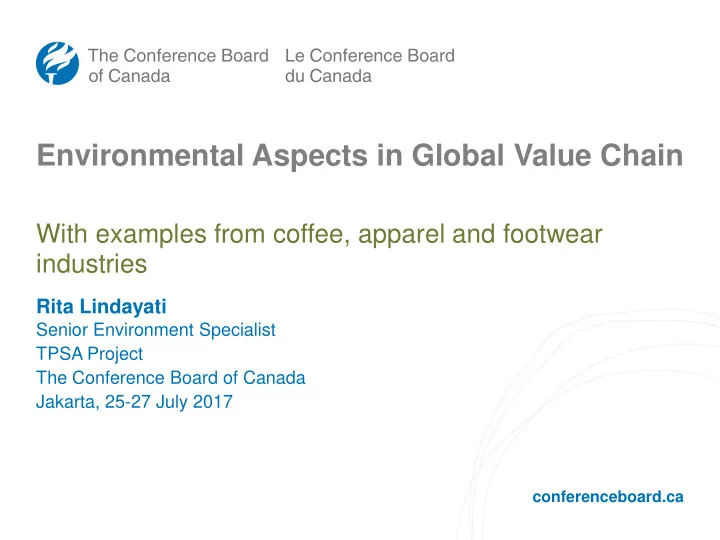

Environmental Aspects in Global Value Chain With examples from coffee, apparel and footwear industries Rita Lindayati Senior Environment Specialist TPSA Project The Conference Board of Canada Jakarta, 25-27 July 2017 conferenceboard.ca
Overview WHAT? • What are the environmental aspects of GVCs? WHY • Why do we care about environmental issues in GVCs? • GVC Environmental Impacts in Developing Countries HOW? • How to achieve greener value chains? WHEN • When does it pay to be green? 2
WHAT? What are the environmental aspects of GVCs? Environmental aspects in global value chains (GVC): the integration of environmental considerations into “the full range of activities to bring a product from its conception to end use and beyond.” The goal of environmental integration is to reduce negative environmental impacts and increase the positive ones https://globalvaluechains.org/ 3
WHY? Why do we care about environmental issues in GVCs? • Environment is embedded in the value chains since the majority of economic activities require environmental inputs (e.g., natural resources, energy) from, and produce waste to, the environment • The longer a product’s value chains, and the bigger its trade volume, the greater environmental impacts • The environmental impacts of globally traded commodities are spread between exporting and importing countries • A product lifecycle assessment provides a method to understanding the environmental impacts of its global value chains 4
Some highlights in coffee industry: • Coffee is the world’s second largest traded commodity after oil with $30-32 billion market worldwide ( Specialty Coffee Association of America, 2012 ) • With global consumption of approximately 1.6 billion cups per day, the social, economic, and environmental impacts of coffee industry are substantial ( International Coffee Organization/ICO ) • Carbon footprint of 1 kg green coffee bean (produced in Costa Rica and consumed in Europe) is approximately 4.98 kg CO2e (http://www.balas.org/BALAS_2013_proceedings_data/data/documents/p639212.pdf) • World coffee exports amounted 91.3 million bags (@60kg) in 2016 (www.ICO.org) and thus, potentially produced 27.28 megaton CO2e. The greenhouse gas emissions are spread globally between producing and consuming countries. • On average, one acre of new forest can sequester about 2.5 tons of carbon annually ( Gopan, 2014 ). More than 10 million ha forest required to sequester 27.28 megaton CO2e ? 5
Apparel/ footwear http://www.ecouterre.com 6
In 2010 the world produced and purchased almost 25 billion shoes, nearly all of which (more than 90%) were manufactured in developing countries (Sport Business Research Network, 2011) A typical pair of running shoes made of synthetic materials produced approx. 14 (+/- 2.7)kg CO2e (http://hdl.handle.net/1721.1/102070) 7
Environmental Aspects in A Product Life-cycle Inputs Life-cycle stages Outputs Atmospheric emission Raw material acquisition Raw Materials Waterborne waste Manufacturing Solid waste Energy Use/maintenance By-products Other releases End of life/recycle/waste Source: US-EPA 8
Distribution of environmental impacts depend on where the economic activities take place 9
GVC Environmental Impacts in Developing Countries Two opposing opinions on global and free trade impact on environment: (-) Some argue environmental quality will be compromised as developing countries will adopt less stringent environmental standards to increase their global competitiveness (“race to the bottom” hypotheses) (+) Others argue that trade globalization could encourage more efficient allocation of resources, technical innovation, improved environmental standards (to meet the requirements from the developed markets) and the adoption of corporate codes of conduct (“gains from trade” hypotheses) 10
Understanding A Product’s Environmental Impacts through Lifecycle Analysis • Life Cycle Assessment method provides a tool to assess environmental impacts (i.e., resource consumptions and emission to the environment) across the full life cycle of a product, from material acquisition to manufacturing, use, and final disposal. • Environmental “hotspots” refer to the activity that cause the highest environmental impacts in a product lifecycle (e.g. dyeing process in textile manufacture). • If environmental hotspots are known, efforts to reduced environmental impacts can be focused. 11
Example from coffee lifecycle CO2e emissions of 1 kg coffee green bean produced in Costa Rica, consumed in Europe (http://www.balas.org/BALAS_2013_proceedings_data/data/documents/p639212.pdf) 12
Environmental Hotspots for CO2 emissions (http://www.balas.org/BALAS_2013_proceedings_data/data/documents/p639212.pdf) ((( (http://www.balas.org/BALAS_2013_proce edings_data/data/documents/p639212.pdf) \ 13
Different CO2e emissions of different types of coffee 14
15
A typical pair of running shoes generates 30 pounds of carbon dioxide emissions, equivalent to keeping a 100-watt light bulb on for one week (MIT, 2013) 16
HOW • How to achieve greener value chains? • The concept of green value chains is to integrate environmental thinking into supply chain management. • GVC aims to minimize or eliminate adverse environmental impacts along supply chain, from product design, material resourcing and selection, manufacturing process, delivery of final product and end-of-life management of the product ( Thoo Ai Chin et al., 2015 ) 17
Various business initiatives to make a greener value chain 18
Green measures in Nestle product lifecycle 19
Most popular coffee ecolabels in Canada 20
Global distribution of sustainable coffee growing areas Source: IISD Sustainable Coffee 2010 21
Green apparel Source: Internet 22
Cloth recycling in one of H&M stores, Singapore (source: internet) 23
Green Footwear (Source: internet) 24
WHEN When does it pay to be green? Generic competitive environmental strategies Strategy 1: Strategy 4: Lower costs Environmental Eco-efficiency Cost Leadership (e.g., firms adopting Reduce, Reuse, Recycle Comparative (e.g., biodegradable practices) packaging) advantage Strategy 2: Strategy 3: Product Beyond Compliance Eco-Branding differentiation Leadership (e.g., organic coffee, organic (e.g., ISO 14001 certification) apparel, eco-friendly vegan footwear) Organizational Product/ process services Source: Orsato, 2006 25
26
Recommend
More recommend